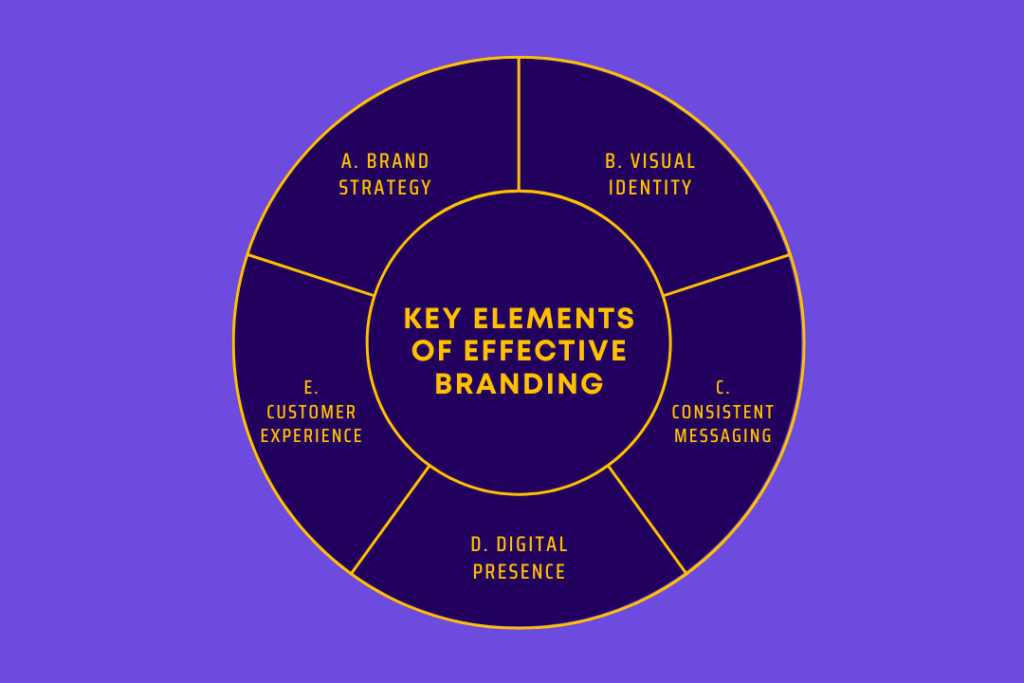I. Introduction
In today’s highly competitive business landscape, creating and maintaining a strong brand has become more important than ever. But why is business branding so essential? In this article, we will explore the importance of business branding, key elements of effective branding, and how to develop a strong brand for your business.
II. What is business branding?
Business branding is the process of creating and promoting a unique identity for your business that differentiates it from competitors. It includes elements like your company’s name, logo, tagline, colors, and overall design aesthetics. It also encompasses the message and values you want to convey to your target audience, both through marketing and customer interactions.
III. Importance of business branding
A. Recognition
A strong brand helps your business stand out in a crowded market. A recognizable logo, color scheme, or tagline can create a lasting impression in the minds of your customers. This recognition leads to increased customer recall and higher chances of customers choosing your business over competitors.
B. Customer loyalty
When customers have a positive experience with your brand, they are more likely to become loyal customers. A well-defined brand establishes trust and credibility, which can lead to repeat business and word-of-mouth referrals. Consistent branding efforts help ensure that your customers feel connected to your brand and identify with its values.
C. Employee satisfaction
A strong brand can also have a positive impact on employee satisfaction. When employees are proud of the company they work for, they are more likely to be engaged, productive, and committed to the business’s success. A clear brand identity can help employees understand the company’s mission and values, which can increase their sense of purpose and belonging.
D. Competitive edge
In a competitive marketplace, a strong brand can be the difference between success and failure. A well-established brand can set your business apart from competitors and make it easier for customers to choose your products or services. Additionally, a powerful brand can act as a barrier to entry for new competitors looking to break into the market.
E. Financial value
Businesses with strong brands tend to have higher financial value. A powerful brand can lead to increased customer loyalty, repeat business, and higher market share, all of which contribute to a company’s bottom line. In some cases, the brand itself can become a valuable asset when calculating the overall worth of a business.
IV. Key elements of effective branding

A. Brand strategy
A solid brand strategy is the foundation for successful branding efforts. It involves defining your target audience, competitive positioning, and unique selling proposition. This strategy guides
all your branding efforts and ensures consistency across all touchpoints with customers.
B. Visual identity
Your brand’s visual identity includes the logo, color scheme, typography, and other design elements. These visual elements should be consistent and reflect your brand’s personality and values. A well-designed visual identity can create a memorable impression and contribute to brand recognition.
C. Consistent messaging
Consistency in messaging is crucial for effective branding. Your brand’s tone of voice, values, and messaging should be aligned across all marketing channels, from your website and social media to print materials and advertising campaigns. This consistency helps build trust and credibility with your target audience.
D. Digital presence
In today’s digital age, having a strong online presence is essential for your brand. This includes a user-friendly website, active social media profiles, and a robust content marketing strategy. Your digital presence should accurately represent your brand and provide valuable information and resources for your target audience.
E. Customer experience
The customer experience is a critical component of effective branding. From the first interaction with your business to post-purchase support, every touchpoint should align with your brand’s values and messaging. By providing a positive and consistent customer experience, you can build lasting relationships with your customers and foster brand loyalty.
V. How to develop a strong business brand
- Begin by defining your brand’s purpose, values, and personality.
- Conduct market research to understand your target audience and competitors.
- Develop a clear brand strategy and unique selling proposition.
- Design a visually appealing and consistent visual identity.
- Ensure consistency in messaging across all marketing channels.
- Invest in a strong digital presence and content marketing.
- Focus on providing an exceptional customer experience.
- Monitor and adapt your branding efforts as your business grows and evolves.
VI. Challenges in maintaining a strong brand
Maintaining a strong brand requires ongoing effort and attention. Some challenges businesses face include:
- Adapting to changing market trends and consumer preferences.
- Ensuring consistent branding during periods of growth or organizational change.
- Staying relevant and innovative in a competitive marketplace.
- Balancing the need for brand consistency with the desire for personalization and customization.
- Managing negative customer experiences or public relations issues that can harm your brand’s reputation.
VII. Conclusion
Business branding is essential for companies of all sizes and industries. A strong brand helps create recognition, foster customer loyalty, improve employee satisfaction, provide a competitive edge, and increase financial value. By focusing on key elements of effective branding, such as brand strategy, visual identity, consistent messaging, digital presence, and customer experience, businesses can develop a powerful and lasting brand that drives success.
VIII. FAQs
1. Can a small business benefit from investing in branding efforts? Absolutely. Even small businesses can benefit from establishing a strong brand identity, as it helps differentiate them from competitors and creates trust with customers.
2. How often should I update my brand? While there is no set rule for how often to update your brand, it’s essential to regularly evaluate its effectiveness and make changes when necessary. This could involve minor tweaks or a complete rebrand, depending on your business’s needs and market conditions.
3. What is the role of employees in branding? Employees play a crucial role in representing your brand to customers and the public. Ensuring they understand and embody your brand’s values and messaging can help create a consistent and positive brand experience.
4. How can I measure the success of my branding efforts? There are several ways to measure the success of your branding efforts, including tracking brand awareness, customer loyalty, and overall business performance. Regularly evaluating these metrics can help you
Contact Mafita Tech Pvt Ltd for your Business Branding Project – contact@mafitatech.com
Click Here to see our latest projects.
Read our other articles on Photoshop




